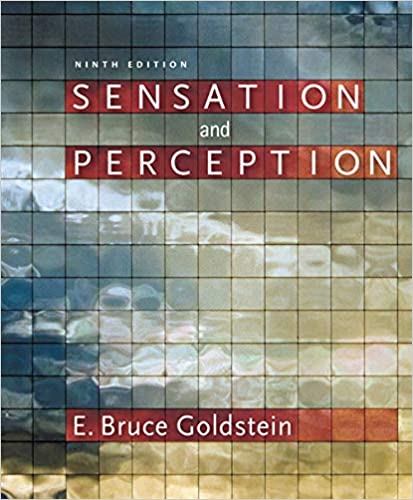
Sensation and Perception 9th Edition by Bruce Goldstein
Edition 9ISBN: 978-1133958475
Sensation and Perception 9th Edition by Bruce Goldstein
Edition 9ISBN: 978-1133958475 Exercise 1
Ralph, who is skeptical about the function of lateral inhibition, says, "OK, so lateral inhibition causes us to see Mach bands and the spots at the intersections of the Hermann grid. Even though these perceptual effects are interesting, they don't seem very important to me. If they didn't exist, we would see the world in just about the same way as we do with them." (a) How would you respond to Ralph if you wanted to make an argument for the importance of lateral inhibition? (b) What is the possibility that Ralph could be right?
Figure 1
(a) Four squares of the Hermann grid, as in Figure 2, but now focusing on receptor D, which is flanked by two black squares. Receptor D is surrounded by receptors A, F, G, and H. Notice that receptors F and H are located under the two black squares, so they receive less light than the other receptors. (b) Perspective view of the grid and five receptors, showing how the receptors (green) connect to bipolar cells (blue). The response of receptors A and G is 100, and the response of F and H is 20. Lateral inhibition travels to bipolar D along the red pathways.

Figure 2
a) Four squares of the Hermann grid, showing five of the receptors under the pattern. Receptor A is located at the intersection, and B, C, D, and E have a black square on either side. (b) Perspective view of the grid and five receptors, showing how the receptors (green) connect to bipolar cells (blue). The response of all fi ve receptors is 100. The initial response of the bipolars matches the response of the receptors. Lateral inhibition travels to bipolar cell A along the red pathways.

Figure 1
(a) Four squares of the Hermann grid, as in Figure 2, but now focusing on receptor D, which is flanked by two black squares. Receptor D is surrounded by receptors A, F, G, and H. Notice that receptors F and H are located under the two black squares, so they receive less light than the other receptors. (b) Perspective view of the grid and five receptors, showing how the receptors (green) connect to bipolar cells (blue). The response of receptors A and G is 100, and the response of F and H is 20. Lateral inhibition travels to bipolar D along the red pathways.

Figure 2
a) Four squares of the Hermann grid, showing five of the receptors under the pattern. Receptor A is located at the intersection, and B, C, D, and E have a black square on either side. (b) Perspective view of the grid and five receptors, showing how the receptors (green) connect to bipolar cells (blue). The response of all fi ve receptors is 100. The initial response of the bipolars matches the response of the receptors. Lateral inhibition travels to bipolar cell A along the red pathways.

Explanation
Lateral inhibition is the process in the...
Sensation and Perception 9th Edition by Bruce Goldstein
Why don’t you like this exercise?
Other Minimum 8 character and maximum 255 character
Character 255


